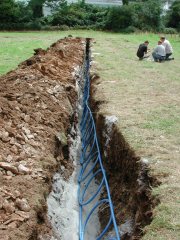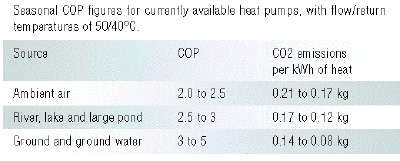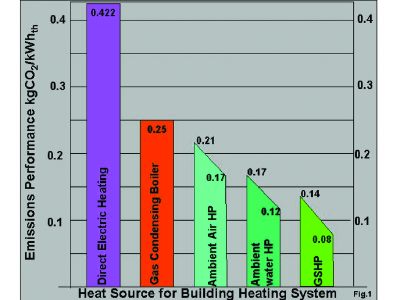Renewable heat – the era of ground-source heat pumps

The time has arrived for ground-source heat pumps — Professor Terry Wyatt.

Given sufficient ground area, coils can be dropped into narrow trenches — such as this scheme for new-build domestic housing at Flushing in Cornwall. (Photo: EarthEnergy Systems, GeoScience Ltd)
Implementing of the UK White Paper for reducing Carbon Emissions requires step changes in the emissions performance of heating and hot-water systems in buildings. These systems are currently responsible for about half the emissions of buildings. They amount to some 55 Mt of carbon a year, and account for around 37% of total UK emissions. Whilst great consideration for future UK energy use has been focused on electricity, far less attention has been given to heat. Electricity generation accounts for around 30% of emissions, and about 5% of that goes to heating buildings. Clearly the larger potential, for cutting of emissions from heating energy, deserves far greater attention. Building Regulations Part L 2005 and the Energy Performance of Buildings Directive 2006, are bringing emissions performance requirements that will effectively preclude use of electrical heating for buildings. This will be a problem to buildings where gas is not available (some 30 000 new homes a year do not have mains gas) and to all existing buildings, with electric heating needing to cut their emissions for a better EPBD label. Heat pumps, particularly GSHP will find their place here. The important feature of the heat pump is its coefficient of performance (COP). It indicates the efficiency with which heat energy is transferred from a low-grade, (temperature), source to a higher-grade user system. The COP is the ratio of the energy employed in the heat pump to that delivered for use, Or kWh used in the motor drives of the heat pump, compared to the kWh delivered for use.
Seasonal COP figures for currently available heat pumps, with flow/return temperatures of 50/40°C.
The operational COP of a heat pump is determined by two key factors. • The temperature ‘lift’ from the low-grade source to the higher-grade delivered. • The efficiency of the heat pump and its drives, including any ‘parasitic’ loads such as associated pumps or fans. If ambient air is the source, the ‘lift’ will change appreciably with the weather over a day and through the year. Unfortunately the greatest need for heat will coincide with the lowest temperature of the air source. Ground-source heat pumps do not suffer this problem and nor, to a lesser extent, do many water sources. The important factor is the seasonal or annual COP of a system and this, quite simply, is the ratio of heat energy delivered in a season to the electrical energy used to make that delivery. Thereafter the all-important carbon-emissions performance of a system is determined by: • the seasonal COP; • the emissions characteristic of the primary energy source. Electricity from the Grid has emissions of 0.422 kg of carbon dioxide or 0.115 kg of carbon per kWh, calculated according to Part L 2005. The seasonal emissions performance for carbon dioxide emissions (kg) of an electrically driven system is thus: (0.422 x kWh of heat delivered)/seasonal COP To obtain a figure for carbon emissions, substitute 0.115 for the 0.422. Seasonal COPs for currently available heat pumps and the related carbon-dioxide emissions are summarised in the table. These figures are for systems where the delivered heat is required at temperatures up to 50°C with system return water temperatures down to 40°C. These temperatures are fine for well-insulated buildings and are particularly suited to underfloor or embedded-panel heating methods.
Fig. 1: Heat pumps achieve lower carbon-dioxde emissions than other forms of heating — with ground-source heat pumps performing best of all.

Fig. 2: Temperatures in the ground become more stable with increasing depth, which is particularly advantageous for heat pumps used for heating and cooling.
Carbon-dioxide emissions for heat obtained from a gas-fired condensing boiler operating at 80% seasonal efficiency are 0.25 kg/kWh of heat A GSHP can thus reduce emissions by 50 to 60% of emissions. Similarly, a cut of 70% to 80% is delivered over a direct electrical source for a building’s heating system. It is easy to appreciate the keenness of Government to see GSHPs exploited. The amount of heat that is readily accessible, in the ground depends on the location, geology and depth accessed. For heating systems for individual buildings, the depth involved is, for economic reasons, restricted to 200 m — so deep geothermal heat is not involved. At depths from 15 to 200 m, in the UK, the temperature of the ground and any intrinsic water is at around 10 to 12°C all year round, varying as shown in Fig. 2. The thermal conductivity of ground rock in the UK ranges from about 1.5 to 3.5 W/m/K. The objective of a system is to remove heat whilst changing ground temperature as little as possible. Boreholes should generally be more than 10 m apart. Present practical and economic considerations make it sensible for boreholes to have a maximum depth of 50 to 150 m, as this enables use of normal water borehole drilling equipment. Similarly the borehole diameter will be 120 mm, which is suitable for a single or double 32 mm HDPE pipe loop. Alternatively, where a sufficient site area is available, the heat-gathering pipe loop can be arranged horizontally in the ground at 2 to 3 metres depth. At such depths, the ground temperature will increase, in summer as shown. This may be important for systems that are also employed for summertime, low-carbon, cooling. Current costs Costs for a GSHP system at present show considerable variance, beyond that of alternative conventional systems. As a general guide £1000/kW of heat output can be taken. This capital investment is to be offset by savings of operating costs for heating energy, system maintenance, and Carbon Levy or any future carbon taxation or trading’.







